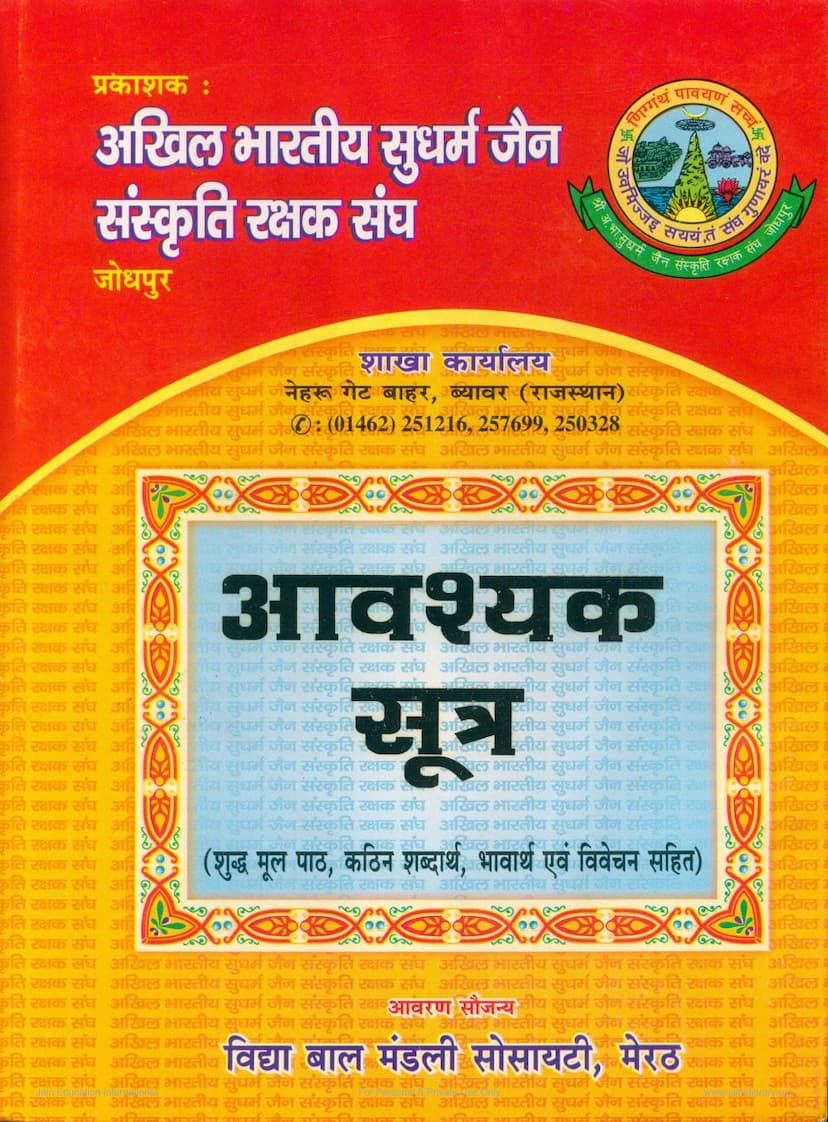Aavashyak Sutra
Added to library: September 1, 2025

Summary
The provided text is a comprehensive Jain scripture titled "Aavashyak Sutra", authored by Nemichand Banthiya and Parasmal Chandaliya, and published by Akhil Bharatiya Sudharm Jain Sanskruti Rakshak Sangh. It details the six essential daily practices for Jain ascetics and lay followers.
Here's a breakdown of the key aspects of the Aavashyak Sutra based on the provided text:
Core Concept:
- The Aavashyak Sutra is considered the "lifeblood of spiritual practice" in Jainism and is considered essential for purification, atonement, and self-improvement. It's mandatory for ascetics and highly recommended for laypeople.
- It emphasizes self-introspection, self-examination, and self-elevation through a systematic daily regimen.
The Six Essential Practices (Aavashyakas):
The text meticulously details each of the six Aavashyakas, explaining their purpose, sequence, and significance:
-
Samayik (सामायिक):
- Meaning: Achieving equanimity, remaining undisturbed by external circumstances or internal passions (like anger, pride, deceit, greed), and practicing impartiality towards all living beings. It's about dwelling in one's own soul or pure self.
- Significance: Considered the essence of all spiritual practice. It's the foundational step for all other practices. The text emphasizes that liberation is achieved solely through the practice of Samayik. It can lead to the cessation or significant reduction of worldly wandering and karmic accumulation.
- Types: Shrut Samayik (study of scriptures), Samyakva Samayik (attaining the fourth stage of spiritual development), Desh Virat Samayik (lay followers adhering to vows), and Sarva Virat Samayik (ascetics' complete renunciation).
-
Chaturvinshtistav (चतुर्विंशतिस्तव):
- Meaning: Praising the virtues and qualities of the 24 Tirthankaras (Enlightened beings).
- Significance: This practice is done to stabilize the equanimity achieved in Samayik by focusing on an ideal. Praising the Tirthankaras calms the mind, purifies the heart, instills courage to face hardships, and promotes spiritual growth. It leads to purification of perception.
-
Vandana (वंदना):
- Meaning: Showing respect and devotion to one's spiritual teachers (Gurus) through mind, speech, and body.
- Significance: Humility and respect for the Guru are considered the root of dharma. It leads to the destruction of ego, the binding of higher karmas, and the acquisition of good fortune. True Vandana is offered to those who possess material and spiritual conduct (dravya and bhava charitra) and is done without any ulterior motive.
-
Pratikraman (प्रतिक्रमण):
- Meaning: "Returning" or "going back." It involves acknowledging and atoning for any faults or lapses committed during the day or night due to ignorance, carelessness, passions, or wrong inclinations. It's a process of purification and correction.
- Significance: It's described as an essential medicine for spiritual health – it cures existing diseases (sins) and prevents future ones, while also strengthening the body (soul). It's compared to a diligent merchant's daily account-keeping. It helps in refining one's conduct, rectifying mistakes, and reaffirming vows.
- Etymology: "Prati" means contrary or reversed, and "kraman" means movement. Therefore, Pratikraman means returning to the right path from a wrong one.
-
Kayotsarga (कायोत्सर्ग):
- Meaning: "Abandonment of the body." This involves detaching oneself from the physical body and its sensations, stabilizing the mind and body, and focusing inwardly. It's about transcending the physical self while inhabiting the body.
- Significance: This practice strengthens willpower and makes the practitioner steadfast against any adversities (upasarga) from humans, animals, or celestial beings. It's considered a method for special purification, clearing any residual impurities left after Pratikraman, acting like a healing balm for faults incurred.
-
Pratyakhyan (प्रत्याख्यान):
- Meaning: Renunciation or taking vows to abstain from certain actions, desires, or objects. It's about controlling and limiting one's desires.
- Significance: This is the final step, focused on preventing future wrongdoing by renouncing desires. Unchecked desires lead to suffering and attachment to the cycle of birth and death. By limiting desires through Pratyakhyan, one achieves peace, controls the influx of karmas (asrava), and progresses towards liberation.
Structure and Content:
The book appears to be a detailed exposition of the Aavashyak Sutra, including:
- Original text (मूल पाठ): Likely the canonical verses.
- Difficult words and their meanings (कठिन शब्दार्थ): Explaining obscure terminology.
- Essence/Meaning (भावार्थ): The underlying philosophical and practical meaning.
- Commentary/Explanation (विवेचन): In-depth analysis and elaboration of each practice.
Key Philosophical Underpinnings:
- Cause and Effect: The sequence of the six Aavashyakas is presented as scientifically based on cause and effect, with equanimity (Samayik) being the prerequisite for all subsequent practices.
- Self-Control and Detachment: Central themes are the control of senses, passions, and desires, and detachment from the physical body and worldly possessions.
- Purity and Purification: The entire text is geared towards achieving spiritual purity through introspection, atonement, and renunciation.
- Importance of Guru: The role of the Guru is highlighted, especially in the Vandana and Pratikraman sections, as the guide and facilitator in the spiritual journey.
Publication and Context:
- The publication by Akhil Bharatiya Sudharm Jain Sanskruti Rakshak Sangh indicates a focus on preserving and promoting Jain culture and scriptures.
- The mention of various branch offices and distribution points suggests a widespread effort to make this text accessible.
- The inclusion of "For Personal & Private Use Only" highlights the sacred and personal nature of such religious texts.
In essence, this "Aavashyak Sutra" serves as a practical guide for Jains to live a disciplined, righteous, and spiritually progressive life, leading ultimately towards liberation. The detailed explanations aim to provide a deep understanding of these fundamental practices.